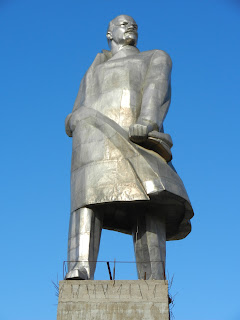‘The rarest and most beautiful of the great cats’ – as
described by Peter Matthiessen – was not supposed to be the theme of this
post, nor was Matthiessen’s book ‘The snow leopard’. The book is a
‘misfit’ both spatially and temporally. Published in 1978, it covers
north-western parts of Nepal. A bit too new and a bit too far from Central
Asia, especially if we take the region to be defined by the five states of
Kazakhstan, Kyrgyzstan, Tajikistan, Turkmenistan and Uzbekistan. The snow
leopard is, however, one of the characteristics, if not the defining feature of
Central Asia. It has become an integral part of the countries' cultural
heritage. The mountain cat is the symbol of at least three Central Asian cities: Bishkek, Samarkand and Almaty. It
was the mascot of the 2011 Asian Winter Games, a sporting event held in Astana
and Almaty. The region states are also more and more engaged in the protection
of this endangered species. In a few months’ time Bishkek is to host the
international forum for protection of snow leopards.
 |
| Almaty, coat of arms |
 |
| Bishkek, coat of arms |
 |
| Samarkand, coat of arms |
 |
| Irby, the mascot of the 2011 Asia Winter Games |
‘The snow leopard’ is also – in the most direct sense – a
result of the recent visit to a small, community second-hand bookshop in
Cambridge (http://www.amnesty.org.uk/content.asp?CategoryID=10996). The
eye-catching cover, the beautiful map printed on the endpaper and the
fine-looking graphic ex libris in the Art Nouveau style did their thing and
here we are, reading a book by a traveller, environmental activist and novelist
who, quite surprisingly, worked also as a fisherman and ship captain.
Peter Matthiessen writes: ‘In late September 1973 I set out
on with GS [the zoologist George Schaller] on a journey to the Crystal
Mountain, walking west under Annapurna and north along the Kali Gandaki River.
(...) GS knew of only two Westerners – he was one – who had laid eyes on the
Himalayan snow leopard in the past twenty-five years. The hope of glimpsing
this near mythic beast in the snow mountains was reason enough for the entire
journey’.
The snow leopard (Panthera uncia) is mostly known for its
elusive behaviour and formidable adaptation to living in the harshest of all
possible environments – the cold, high mountain ranges of Asia. Irbis, as it is
more commonly known to the Russian speakers – is accustomed to living at the
altitudes of up to 6,000 m (20,000 ft). Its geographic distribution covers the
Hindu Kush in eastern Afghanistan and the Syr Darya through the mountains of
Pamir, Tian Shan, Karakoram, Kashmir, Kunlun, and the Himalaya to the southern
Siberia.
.JPG) |
| Bishkek, 2010 |









.JPG)